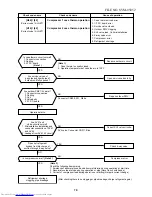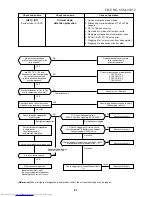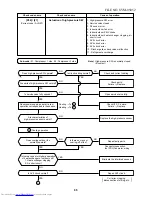
82
In some cases, it may be difficult to check the leakage of clogging in the following condition of refrigerant stagnation
in low ambient temperature condition.
In this case, take a longer operating time prior to check.
(Criterion: Discharge temperature of TD1 and TD2 are 60°C or higher)
(*1)
a) Leakage check for SV3A valve (For multiple outdoor unit system)
• Turn off the power supply, take off connector of SV3A valve, and then start a test operation after power-ON.
• Check the temperature change at secondary side of SV3A valve during operation . (
in the figure.)
→
If temperature is raised, it is a leakage of SV3A valve. Replace SV3A valve.
b) Leakage check for SV3C valve
• Turn off the power supply, take off connector of SV3C valve, and then start a test operation after power-ON.
• After operation for several minutes, check temperature at secondary side of SV3C valve. (
in the figure.)
→
If temperature is high (equivalent to discharge temperature TD), it is a leakage of SV3C valve. Replace
SV3C valve.
(Even if there is leakage from SV3C valve does not occur, temperature of SV3C valve at secondary side
rises during operation. When the checked temperature is equivalent to TD temperature, it is a leakage of
SV3C valve. Replace SV3C valve.)
c) Clogging check for SV3B valve (For multiple outdoor unit system)
• While outdoor unit is operated, set up SW01/02/03 = [2] [1] [3] to 7-segment display [Hr] [ 2], and push SW04
for 2 seconds or more.
• Set up SW02 = [9], and turn on SV3A, SV3B, SV3C valves. (7-segment display [Hr] [ 3–])
• While outdoor unit is operating, check temperature change at secondary side of SV3B valve. (
in the figure.)
→
If temperature does not rise (equivalent to suction temperature), it is a clogging of SV3B valve.
Replace SV3B valve.
d) Clogging for SV3E valve
Reset the power supply.
ò
Referring to “Valve forced open/close function” of the outdoor unit, check ON/OFF operation (Sound, coil surface
temp up) of SV3E valve is performed.
ò
Start test operation in COOL or HEAT mode.
ò
After operation for several minutes, check the pipe temperature at the secondary side of SV3E valve whether
temperature changes or not. If it is equivalent to outside temperature, clogging of SV3E is considered.
(
in the figure.)
(Reference)
If SV3E valve is clogged, temperature of all TK1, TK2, TK3, and TK4 do not change.
(*2) Clogging check for SV3D valve of oil return circuit from oil separator
a) Oil return circuit
• While outdoor unit is operating, check temperature (secondary side of capillary) on oil return circuit.
(
in the figure.)
→
If temperature is low equivalent to suction temperature), a clogging of strainer of oil return circuit or capillary
is considered. Repair the clogged part.
b) Clogging check for SV3D valve
• While outdoor unit is operating, set up SW01/02/03 = [2] [1] [3] to 7-segment display [Hr] [ 2], and push SW04
for 2 seconds or more.
• Set up SW02 = [6], and turn on SV3D valve. (7-segment display [Hr] [ 3d])
• If temperature is low at secondary side of the valve or it does not change, clogging of valve, capillary, or strainer
is considered. (
in the figure.)
FILE NO. SVM-05052
Summary of Contents for MMK-AP0072H
Page 125: ...TOSHIBA CARRIER CORPORATION ...
















































